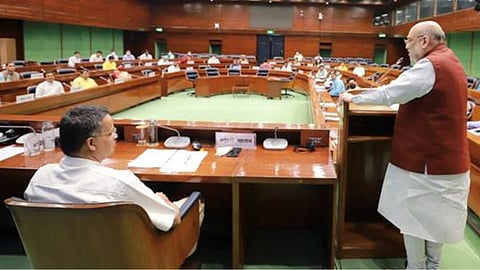

CHENNAI: The Committee of Parliament on Official Language, chaired by Union Home Minister Amit Shah has recently pushed forth a directive that was viewed as a blatant imposition of Hindi on non-Hindi speaking States of India. The panel had mandated that the medium of instruction in all technical or non-technical educational institutions including central universities should be Hindi or local languages. English should be used as a medium only in exceptional cases, and that gradually, it should be phased out to make way for Hindi or regional languages.
Institutions like IIMs, IITs, AIIMSs, Kendriya Vidyalayas and central universities are covered under this rule. To top it off, the committee has suggested the removal of mandatory English language question papers in recruitment examinations, stating that they put non-English speakers at a disadvantage. The panel has also asked for Hindi translation for all high court orders and performance-appraisal related ‘penalties’ for government officers who do not communicate in Hindi in Hindi-speaking States.
In Tamil Nadu, which has a history of staging anti-Hindi agitations, the measures have invited the wrath of Chief Minister MK Stalin, who told the Centre to avoid shoving Hindi down the throats of the populace. The Tamil Nadu legislative assembly also adopted a resolution against the imposition of Hindi by the Centre. Adding that the State will request the Centre to dismiss the recommendations made by the Official Language panel, the CM pointed out that all Indian languages must be treated equally, and that includes Tamil which is part of the Eighth Schedule of the Constitution.
In 1967, former Chief Minister CN Annadurai had come out with a two language policy for Tamil Nadu. India’s first PM Nehru had also assured citizens in the southern heartland that English would remain one of the official languages for as long as the non-Hindi speaking population wanted. The recommendations made by the Shah-led panel are in contravention of these existing measures.
So how feasible is this transition to Hindi or regional languages, in the context of non-Hindi speaking States? Post-independence, educational institutions in India have been imparting education in pure sciences and mathematics to students through the English medium. It’s imperative that we ask — are educational institutions infrastructurally ready to implement such a massive change?
If at all the changes have to be implemented, is there a hand-holding period, where students can be eased into these subjects in their own mother tongues? Think about the learning curve of a student who until Class 5 referred to triangles in English and is suddenly confronted next year with a new textbook that calls a triangle a ‘trikon’.
And how do we indigenise complex biological and anatomical terminology, many of which are derivatives of Latin. Attempting a verbatim translation of Medulla Oblongata in chaste Tamil and Hindi would be quite a task. And how does one account for students from south/East India travelling to Hindi-speaking States to appear in competitive exams? Do we sideline their interests by compelling them to attempt examinations in Hindi, a language that is not their mother tongue?
English is not the enemy but an enabler in a nation with such a pluralistic, multicultural milieu. Such myopic linguistic drives focused on promoting just one language as the lingua franca of India might only serve as a misplaced sense of jingoism.
Visit news.dtnext.in to explore our interactive epaper!
Download the DT Next app for more exciting features!
Click here for iOS
Click here for Android